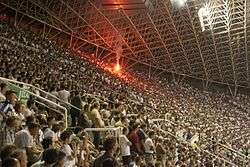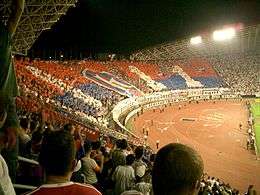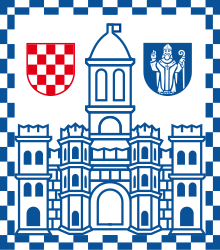Stadion Poljud
|
Poljudska ljepotica | |
 | |
| Full name | Gradski stadion u Poljudu |
|---|---|
| Location | Split, Croatia |
| Coordinates | 43°31′10″N 16°25′54″E / 43.51944°N 16.43167°ECoordinates: 43°31′10″N 16°25′54″E / 43.51944°N 16.43167°E |
| Owner | City of Split |
| Operator | Hajduk Split |
| Capacity | 34,198 |
| Field size | 105 m x 68 m (115 yd x 74 yd) |
| Surface | Grass |
| Construction | |
| Built | 1977–1979 |
| Opened | 12 September 1979 |
| Architect | Boris Magaš |
| Structural engineer | Boženko Jelić |
| Tenants | |
|
Hajduk Split (1979–present) Croatia national football team (1995–present) | |
Stadion Poljud is a multi-use stadium in the Croatian city of Split. It takes its name from the neighbourhood of Poljud, and is located on the northern side of the Split peninsula.[1] Its original name is "Gradski stadion u Poljudu" ("City Stadium in Poljud"). The stadium was opened in September 1979 and is the home venue of the Hajduk Split football club. Some of the Croatian national football team's games are played at Poljud, which competes with Maksimir stadium for the biggest matches. The stadium has a capacity of 34,198.[2]
The venue was built to host the 1979 Mediterranean Games and was opened by the then Yugoslav president, Josip Broz Tito. It had an original capacity of 55,000, increased to 62,000 in the 1980s, before being equipped with seats in the 1990s thus reducing the capacity to 35,000.[3]
Poljud Stadium was also the venue for the 1990 European Athletics Championships and the 2010 IAAF Continental Cup, and since 2013, it annually hosts Ultra Europe.
Design

Its trademark is a seashell-like design with roof structure spanning at 205x47 meters. Its design offers views of nearby hills and forests from the stands, modeled after ancient Greek theaters. Suspended on the west roof "shell" are 19 cabins, 7 of them are used by TV reporters, with the others occupied by cameras, central referee station, photo finish, scoreboard, audio control, etc. All of these are interconnected via a catwalk that runs through a structure spanning the entire roof giving access to the cabins, as well as to the 630 Philips lights, placed along the brim and inner side of the roof.

Stands are supported by a construction of reinforced concrete with entrances via 12 bridges placed 30–40 meters apart around the entire stadium as well as eight staircases. Underneath them is a trench holding office areas. The area around the stadium is composed of 60,000 square meters of designed landscape with greenery designated for pedestrians, with the stadium slightly beneath the grade level of surrounding traffic roads. Placed under the western stands are 11,000 square meters of sports facilities (three gyms, pool, sauna), official club offices and restaurants, while the eastern stands cover 9,100 square meters of business areas. The inner stadium ground is composed of 105x68 meters football pitch and 8 running tracks surrounding it.[4]
The stadium was refurbished before hosting the 2010 IAAF Continental Cup athletics competition. A new tartan track was constructed, including the introduction of new VIP boxes and seats.[5] In October 2014, following heavy damage from Ultra Europe, a new pitch and drainage system were constructed, replacing the original ones that lasted for 35 years.[6]
In November 2015 the stadium was officially recognized as culture heritage.[7]
International fixtures
| Date | Competition | Opponent | Score | Att. | Ref |
|---|---|---|---|---|---|
| Yugoslavia (1979–1991) | |||||
| 29 September 1979 | 1979 Mediterranean Games | 3–0 | 50,000 | ||
| 29 April 1981 | 1982 FIFA World Cup qualification | 5–1 | 45,000 | ||
| 21 December 1983 | UEFA Euro 1984 qualifying | 3–2 | 29,331 | ||
| 29 October 1986 | UEFA Euro 1988 qualifying | 4–0 | 12,270 | ||
| 31 March 1988 | Friendly | 1–1 | 12,000 | ||
| Croatia (1991–present) | |||||
| 8 October 1995 | UEFA Euro 1996 qualifying | 1–1 | 35,000 | ||
| 29 March 1997 | 1998 FIFA World Cup qualification | 1–1 | 35,000 | ||
| 2 April 1997 | 1998 FIFA World Cup qualification | 3–3 | 20,000 | ||
| 10 February 1999 | Friendly | 0–1 | 7,000 | ||
| 23 February 2000 | Friendly | 0–0 | 10,000 | ||
| 12 February 2003 | 2003 Marjan Trophy | 0–0 | 1,000 | ||
| 18 February 2004 | Friendly | 1–2 | 9,212 | ||
| 17 August 2005 | Friendly | 1–1 | 27,256 | ||
| 6 February 2008 | Friendly | 0–3 | 30,000 | ||
| 4 June 2011 | UEFA Euro 2012 qualifying | 2–1 | 28,000 | ||
| 15 August 2012 | Friendly | 2–4 | 10,000 | ||
| 12 June 2015 | UEFA Euro 2016 qualifying | 1–1 | 0 | ||
References
- ↑ "Stadion Poljud". The Stadium Guide. Retrieved 15 August 2010.
- ↑ "O Poljudu". HNK Hajduk Split (in Croatian). Retrieved 26 April 2011.
- ↑ Budget Airline Football – Football in Split
- ↑ hajduk.hr (1 December 2015). "Stadion Poljud - kulturno dobro Republike Hrvatske" (in Croatian). Retrieved 19 May 2016.
- ↑ "New seating boxes in Poljud stadium coming soon". split2010cc.com. 20 May 2010. Archived from the original on August 29, 2014. Retrieved 15 August 2010.
- ↑ nogometplus.net (23 October 2014). "Obnova poljudskog travnjaka najjeftinija u regiji" (in Croatian). Retrieved 19 May 2016.
- ↑ tportal.hr (1 December 2015). "Stadion Poljud proglašen zaštićenim kulturnim dobrom" (in Croatian). Retrieved 19 May 2016.
External links
| Wikimedia Commons has media related to Gradski stadion u Poljudu. |
| Preceded by Neckarstadion Stuttgart |
European Athletics Championships Main Venue 1990 |
Succeeded by Helsingin olympiastadion Helsinki |
